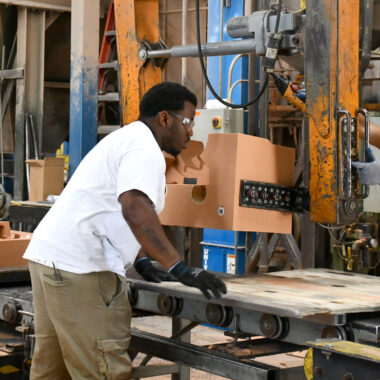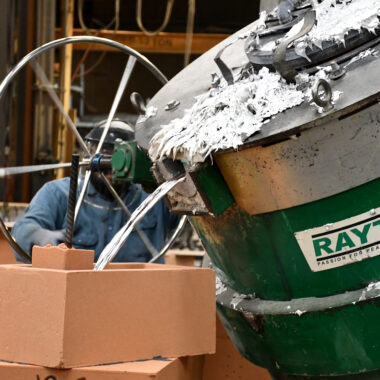Professional Aluminum Casting Illinois: Accuracy and Performance
Professional Aluminum Casting Illinois: Accuracy and Performance
Blog Article
Mastering the Craft: Specialist Tips for Flawless Aluminum Casting Outcomes
In the realm of light weight aluminum expertise, spreading and accuracy are extremely important to attain impeccable outcomes. Mastering the craft calls for a meticulous understanding of the devices and devices at one's disposal, an eager eye for preparing the aluminum alloy to precise requirements, and a deft hand in employing optimum casting techniques.
Important Tools and Tools
Aluminum spreading requires specific tools and equipment to guarantee precision and performance in the process. The crucible, usually made of graphite or ceramic materials, stands up to high temperature levels required to melt aluminum. The mold, usually made of steel or sand, forms the liquified aluminum into the desired kind.
In addition, devices like gloves, tongs, and aprons are required to make sure the safety and security of operators working with liquified light weight aluminum. Spending in premium devices and devices not only boosts the accuracy of light weight aluminum casting but additionally contributes to a more efficient and safe manufacturing procedure.
Preparing the Aluminum Alloy
To guarantee the success of the light weight aluminum casting process, precise prep work of the alloy is extremely important. The first step in preparing the light weight aluminum alloy is to thoroughly pick the suitable kind of light weight aluminum based on the attributes required for the final item.
After cleansing, the following vital step is to heat up the aluminum to the suitable temperature for spreading. This procedure, understood as alloy melting, makes sure that the aluminum remains in its liquified kind and all set for casting (aluminum casting illinois). Additionally, managing the temperature throughout melting is vital to stop getting too hot or underheating, which can lead to flaws in the last item. Overall, precise prep work of the aluminum alloy establishes the foundation for an effective spreading procedure and high-quality outcome.
Ideal Casting Methods
Executing specific spreading methods is necessary for accomplishing high-quality results in light weight aluminum casting procedures. The aluminum ought to be heated to the optimum temperature to decrease issues like shrinkage and porosity in the final cast.
In addition, keeping regular putting speed and pressure is crucial to attaining harmony in the cast piece. Slow-moving and steady pouring helps stop turbulence and air entrapment, which can result in blemishes. An additional essential aspect is the usage of degassing agents to get rid of impurities and gases from the molten light weight aluminum, leading to a cleaner last product.

Achieving Smooth Surface Area Completes
For suppliers looking for to enhance the aesthetic charm and quality of their aluminum spreadings, accomplishing smooth surface coatings is an indispensable aspect following accurate spreading methods and appropriate cooling procedures. One key method browse this site to attain smooth surface area coatings is by making use of premium mold and mildews that are properly prepared and kept. The mold and mildew surface area need to be thoroughly cleansed and coated with launch representatives to avoid blemishes moving onto the actors light weight aluminum during the cooling process.
In addition, controlling the air conditioning rate of the light weight aluminum spreading is crucial for attaining a smooth surface finish. Fast air conditioning can cause thermal gradients that cause emerge defects, while slow-moving air conditioning might trigger microstructural issues - aluminum casting illinois. By executing regulated cooling procedures, such as making use of air or water quenching techniques, manufacturers can make certain that the light weight aluminum solidifies consistently, minimizing the likelihood of surface area imperfections
In enhancement to mold and mildew top quality and cooling down treatments, post-casting treatments like shot blasting or chemical etching can further fine-tune the surface coating of aluminum spreadings. These methods assist smoothen out any kind of staying roughness or impurities, leading to a remarkable look that fulfills the finest quality standards.
Quality Control and Troubleshooting

In the world of troubleshooting, it is vital to have an extensive understanding of typical issues that can take place throughout light weight aluminum spreading, such as surface, porosity, or shrinkage abnormalities. Continual renovation through top quality control and troubleshooting methods is fundamental to achieving flawless outcomes in light weight aluminum casting.
Final Thought
Finally, understanding the craft of light weight aluminum casting calls for crucial tools and equipment, proper prep work of the aluminum alloy, optimal spreading techniques, attaining smooth surface coatings, and carrying out quality assurance measures. By adhering to these expert pointers, perfect outcomes can be accomplished in aluminum casting procedures. Quality assurance and troubleshooting are necessary aspects to take into consideration to make sure this website top notch and consistent results in light weight aluminum spreading jobs.
The first step in preparing the light weight aluminum alloy is to very carefully select the proper kind of aluminum based on the features required for the last product.Executing specific spreading techniques is important for attaining high-grade outcomes in aluminum spreading procedures. By grasping these optimal casting techniques, makers can continually produce perfect light weight aluminum spreadings.
For manufacturers seeking to improve the aesthetic appeal and high quality of their light weight aluminum castings, achieving smooth surface coatings is an essential element adhering to specific casting methods and correct cooling procedures.In conclusion, mastering the craft of aluminum casting requires necessary devices and tools, correct prep work of the light weight aluminum alloy, optimum spreading strategies, attaining smooth surface coatings, and applying top quality control actions.
Report this page